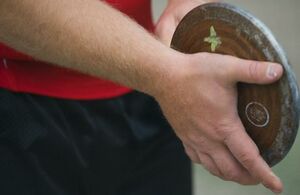The Discus Throw
Original Editor - Matt Huey
Top Contributors - Matt Huey, Kim Jackson and Kirenga Bamurange Liliane
Introduction[edit | edit source]
The discus throw is an event in which the participant throws a heavy disc, called the discus, into a throwing sector for distance. The discus throw was an event involved in the ancient Greek pentathlon dated to around 708 BC.
The discus throw has been apart of the Olympics since 1896 for men and 1928 for women
The discus[edit | edit source]
The discus will vary in weight depending on the level of the competitor. The men's discus will weigh 1.6kg for the high school level and then 2 kg and 22cm in diameter for college and professional. For women, the discus weighs 1 kg and 18 cm in diameter. The discus can be made of wood, plastic, fiberglass, rubber, carbon fiber or metal, depending on the thrower's preference and competition.
Competitors start in a 2.5 m (8 ft 2.25in) throwing circle. Competitors throw the discus into the "sector" which is a partial circle of 34.92 degrees from the center of the throwing circle. Competitors are allowed to standing anywhere in the circle and move through the circle before throwing the discus into the sector.
Rules[edit | edit source]
- Competitors cannot enter the circle until their name has been called
- The competitor throw the discus into the throwing sector.
- Once the discus has landed in the sector the command "mark" is given to which the competitor exits the shot
- A measurement is recorded from the inside of the front of the ring to the mark at which the discus landed
Fouls are called if the competitor performs any of the following violations
- Enters the ring before name being called
- Any portion of the competitor (including clothing) touching the top or outside of the ring
- Exiting the ring before the "mark" command
- Exiting the ring from the front half of the circle
Techniques[edit | edit source]
The most common technique is the competitor starting at the back of the ring, facing out. The discus is held in the hand with the rim in the fingers. For a right handed thrower, they then rotate on the left foot toward the front of the circle. The right foot lands in the middle of the ring, then the left leg comes through to the front of the ring. The competitor uses a sidearm movement to bring the discus forward and then spins the discus off the index or middle finger.
Records[edit | edit source]
| Athlete | Distance | Date | |
|---|---|---|---|
| Men's | Jurgen Schult | 74.08 m (243 ft 1/2in) | June 6, 1986 |
| Women's | Gabriele Reinsch | 76.80 m (251 ft 11.5 in) | July 9, 1988 |
Common Injuries[edit | edit source]
With the rotation movements of the throwing technique, injures to the meniscus can occur in the knee. Due to the discus being held and thrown from the fingers, injures to the hand and fingers can occur. These include volar plate injuries along with tendon injuries[1].
References[edit | edit source]
- ↑ Meron, A., & Saint-Phard, D. (2017). Track and Field Throwing Sports: Injuries and Prevention. Current sports medicine reports, 16(6), 391–396. https://doi.org/10.1249/JSR.0000000000000416







